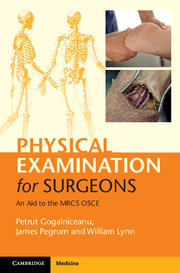Book contents
- Frontmatter
- Dedication
- Contents
- List of contributors
- Introduction
- Acknowledgments
- List of abbreviations
- Section 1 Principles of surgery
- Section 2 General surgery
- Section 3 Breast surgery
- Section 4 Pelvis and perineum
- Section 5 Orthopaedic surgery
- Section 6 Vascular surgery
- Section 7 Heart and thorax
- Section 8 Head and neck surgery
- Section 9 Neurosurgery
- 37 Global neurological examination
- 38 Focal neurological examination
- Section 10 Plastic surgery
- Section 11 Surgical radiology
- Section 12 Airway, trauma and critical care
- Index
38 - Focal neurological examination
from Section 9 - Neurosurgery
Published online by Cambridge University Press: 05 July 2015
- Frontmatter
- Dedication
- Contents
- List of contributors
- Introduction
- Acknowledgments
- List of abbreviations
- Section 1 Principles of surgery
- Section 2 General surgery
- Section 3 Breast surgery
- Section 4 Pelvis and perineum
- Section 5 Orthopaedic surgery
- Section 6 Vascular surgery
- Section 7 Heart and thorax
- Section 8 Head and neck surgery
- Section 9 Neurosurgery
- 37 Global neurological examination
- 38 Focal neurological examination
- Section 10 Plastic surgery
- Section 11 Surgical radiology
- Section 12 Airway, trauma and critical care
- Index
Summary
Neurological examination is traditionally divided into examination of the cranial nerves and examination of the peripheral nervous system. In fact the two routines are complementary, and serve a common primary goal: to localise pathology within the nervous system, central and peripheral. Together with an impression of the type of lesion, derived primarily from the history, this localising information is central to correct interpretation of subsequent cross-sectional imaging.
Examination of the cranial nerves
You may need to select appropriate components of the following examination routines according to the clinical scenarios and guidance provided by examiners. This is a test of frontal lobe function.
Checklist
CN I (olfactory nerve)
• Not routinely tested
CN II (optic nerve)
• Acuity: each eye individually
• Fields: four quadrants to confrontation
• Reflexes: accommodation; direct and consensual light reflex
• Ophthalmoscopy: visualise the disc, exclude papilloedema
CN III, CN IV, CN VI (oculomotor, trochlear, abducens nerves)
• Ask patient to report any double vision during testing.
• Instruct patient to keep the head still.
• Ask patient to follow finger with eyes and report any double vision.
• Move finger to all extremes of gaze in an H-shape, to confirm normal upgaze/downgaze in both eyes, in abduction and adduction.
CN V (trigeminal nerve)
• Assess fine touch sensation in the three divisions:
• ophthalmic (Va) over temple
• maxillary (Vb) over cheek
• mandibular (Vc) over angle of mandible
• Confirm masseter/temporalis contraction on clenching teeth.
• Elicit corneal reflex and jaw jerk.
CN VII (facial nerve)
• Ask patient to:
• raise eyebrows
• close eyes tightly
• puff out cheeks
• show teeth
CN VIII (vestibulocochlear nerve)
• Test recognition of whispered speech in each ear individually.
• Weber's and Rinne's tests.
CN IX (glossopharyngeal nerve)
• Offer to test gag reflex.
• Prompt the patient to cough, looking for a strong cough.
• Prompt the patient to swallow, observing for symmetry.
- Type
- Chapter
- Information
- Physical Examination for SurgeonsAn Aid to the MRCS OSCE, pp. 332 - 352Publisher: Cambridge University PressPrint publication year: 2015

